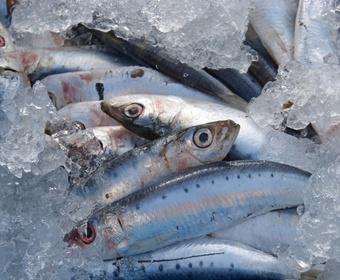
Storing fish
- Ideally chill on ice
- As close to zero °C as possible
- Drain off the liquid
- Freeze properly without air
- Don’t open the oyster packet
The best way to store fresh fish is on ice. The ice isn’t just cold, it’s also dry and allows the meltwater and liquid to run off the fish. However, there are other ways of retaining the freshness and maximizing the storage time of fresh fish.
“Ice fish properly. You need ice on top as well as underneath.”
Therese Gillberg, Hammarströms Fisk, Lisa Elmqvist, and others
Buy your fish last
Fish and shellfish are best when you buy them and then start deteriorating until you cook them. Your enemies are high temperatures, light and the oxygen in the air. Don’t break the cold chain if you can help it. Buy your fish last when you’re shopping and it won’t have time to warm up before reaching your fridge. Use a cool bag if it’s a warm day.
Whole fish are fresher
Choose whole fish and have your fishmonger cut it up for you. Fish that has already been cut into pieces will go off more quickly.
The colder the water, the longer they keep
Lean fish from warm waters – e.g. tilapia and pangasius – keep longest. Fatty fish from cold waters – e.g. salmon and mackerel – have the shortest shelf-life.
Liquid free
Fish lose flavor, consistency and freshness more quickly if they lie in their own juices. The liquid makes the fish flesh deteriorate more quickly. For the best result and to prevent fish from going off for longer, you should store it surrounded by air, in paper, on a rack or in another way that allows any liquid to run off. On ice is ideal.
Freezing is a good alternative
Fish is always slightly worse for being frozen but it’s still a good option. Freeze fish that has to wait a few days before you cook it. It won’t be as good as it was when fresh but it will be better than if you didn’t freeze it. The deterioration is only marginal if you intend to use it in a soup, stew or gratin.
The art of freezing fish:
• Freeze in small pieces/fish as they are.
• Wrap in plastic wrap if they are already frozen.
• Enclose in a final layer that doesn’t allow light through.
• Never re-freeze raw, defrosted fish.
Storage times at -18°C or colder:
• Fatty fish approx. 3 months
• Lean fish approx. 6 months
• Shellfish in liquid approx. 2 months
Don’t freeze fish in trays
When you buy fish in a plastic box in the supermarket, you need to repack it before freezing. Otherwise it will be freeze-dried. You need to get the air out.
Fatty fish freeze well
Fatty fish freeze better and defrost more quickly than lean fish. Water expands when it freezes, which means the cells in the flesh that are filled with liquid will burst from the inside. This has less of an effect with fish that contain a larger proportion of fat.
Defrost slowly
The quality of the flesh keeps better if it is defrosted slowly, e.g. in the fridge. The liquid from the defrosted fish needs to be able to run off.
Lobster and other shellfish should defrost in a mild salt solution so that they don’t dry out. Estimate half as much salt as a normal salt solution, 50 ml salt per liter of water.
Vacuum pack your fish
Most fish can be vacuum packed at the fishmongers. Vacuum pack and freeze if you intend to store the fish a long time.
About 2 days in the fridge
If you buy fresh fish on a Friday to eat on Sunday, it’s fine to keep it in the fridge. But make sure that any liquid can run off.
Cure and salt
Curing and salting fish are methods of preparing and flavoring fish that also preserve it for longer.
Storing shellfish – don’t
Shellfish are an extreme example of a fresh product. The only way to store them is to keep them alive (unless they are deep-frozen). Cook lobster a day in advance if possible. Like crayfish, they’re better for sitting in the cooking liquid. It develops the flavor.
“Don’t store them, eat them.”
Peppe Elmqvist – fourth generation fishmonger – on shellfish
Keep fingers out
If you’ve boiled shellfish that are resting in the cooking liquid, never pick them out with your fingers. Any contamination will spread like wildfire. Use clean implements.
No leftovers
Don’t try to save the leftovers from a half-eaten lobster. Eat all of it. You can turn any spare lobster meat into a seafood salad but you also need to eat that within a reasonable amount of time. One option is to remove the meat from the shell and freeze it carefully without air.
Leftover fish and shellfish are best served cold
Re-heating fish and shellfish makes them taste even “fishier”. This means that the leftovers from your fish and shellfish dinner will taste better in a sandwich, in a salad or in another cold dish.
No mollusks under the ice
Mussels and oysters can live a long time on ice but they shouldn’t end up covered in it. Because it doesn’t contain the right amount of salt, the meltwater will kill them.
Store oysters under pressure
If possible, store oysters under pressure. An expert fishmonger will put them in a tightly tied parcel. Keep it cold – ideally on ice – and don’t open the pack until it’s time to open and serve the oysters. If they are kept cold and sealed, they can last for up to a week.
Exceptions to the rule
There are fish that – lots of people say – taste better after storing for a while. Sole and turbot are two examples. A few days of storage on ice makes them easier to skin.


